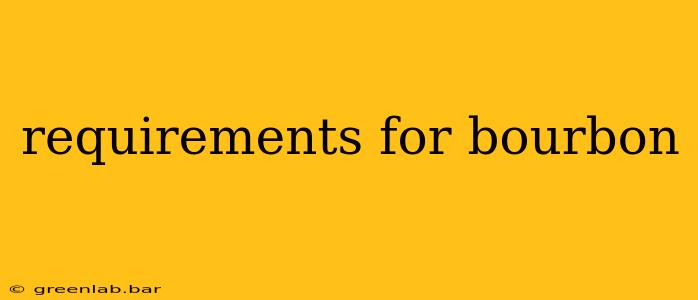Bourbon, a spirit synonymous with American heritage and craftsmanship, holds a special place in the hearts (and glasses) of whiskey enthusiasts worldwide. But what exactly are the requirements that define this iconic amber nectar? This comprehensive guide delves into the precise specifications that govern the production of bourbon, separating fact from fiction and ensuring you can confidently navigate the world of this beloved whiskey.
Key Requirements for Bourbon Whiskey: The Legalities
The defining characteristics of bourbon are enshrined in law, specifically Title 27, Chapter 1, Subchapter A, Part 5 of the Code of Federal Regulations (CFR). These regulations, overseen by the Alcohol and Tobacco Tax and Trade Bureau (TTB), leave no room for ambiguity. Here's a breakdown of the essential requirements:
1. Grain Bill: The Foundation of Flavor
Bourbon must be made from a mash bill (the mixture of grains used in fermentation) where at least 51% of the grains are corn. This corn provides the signature sweetness and contributes significantly to the bourbon's overall character. The remaining percentage can include other grains like rye, wheat, and barley, resulting in a vast spectrum of flavor profiles. The specific ratio of these grains is what differentiates bourbon from one producer to the next.
2. New Charred Oak Barrels: A Crucial Element
The aging process of bourbon is inextricably linked to its flavor. Bourbon must be aged exclusively in new, charred oak barrels. The charring process caramelizes the sugars in the wood, imparting color, vanillin notes (think vanilla), and other complex flavors to the whiskey. The type of oak, level of char, and barrel size all play a role in shaping the final product. Re-used barrels are strictly forbidden.
3. Distillation Proof Restrictions
Bourbon must be distilled to no more than 160 proof (80% alcohol by volume). This limit ensures the integrity of the flavor compounds during fermentation and distillation.
4. Bottling Proof: Minimum Requirements
While the distillation proof is capped, there's no upper limit on the bottling proof. However, it must be bottled at no less than 80 proof (40% alcohol by volume).
5. Made in the USA: Origin Matters
Bourbon must be produced within the United States. This geographical restriction is crucial to the spirit's identity and historical context.
Beyond the Legalities: Understanding the Nuances
While the above requirements define the legal parameters of bourbon, there's much more to consider in understanding its diverse character.
Straight Bourbon: A Higher Standard
The term "straight bourbon" adds another layer of specification. To qualify, it must meet all the requirements listed above and be aged for a minimum of two years in new, charred oak barrels. Many straight bourbons are aged significantly longer, often for several years or even decades.
Age Statements and Beyond
Age statements on bourbon bottles indicate the age of the youngest whiskey in the blend. For example, a "7-year-old bourbon" guarantees that every drop is at least seven years old. However, many bourbons are blends of whiskeys of varying ages. Un-aged bourbon is perfectly legal; it's just not as common.
Conclusion: A Legacy of Quality and Craftsmanship
Understanding the requirements for bourbon goes beyond simply identifying the spirit; it illuminates the dedication and artistry involved in its creation. From the careful selection of grains to the precise aging process in new, charred oak barrels, every step contributes to the unique character of this American icon. Next time you raise a glass of bourbon, appreciate not just its rich flavor, but also the rigorous standards that define its very existence.

